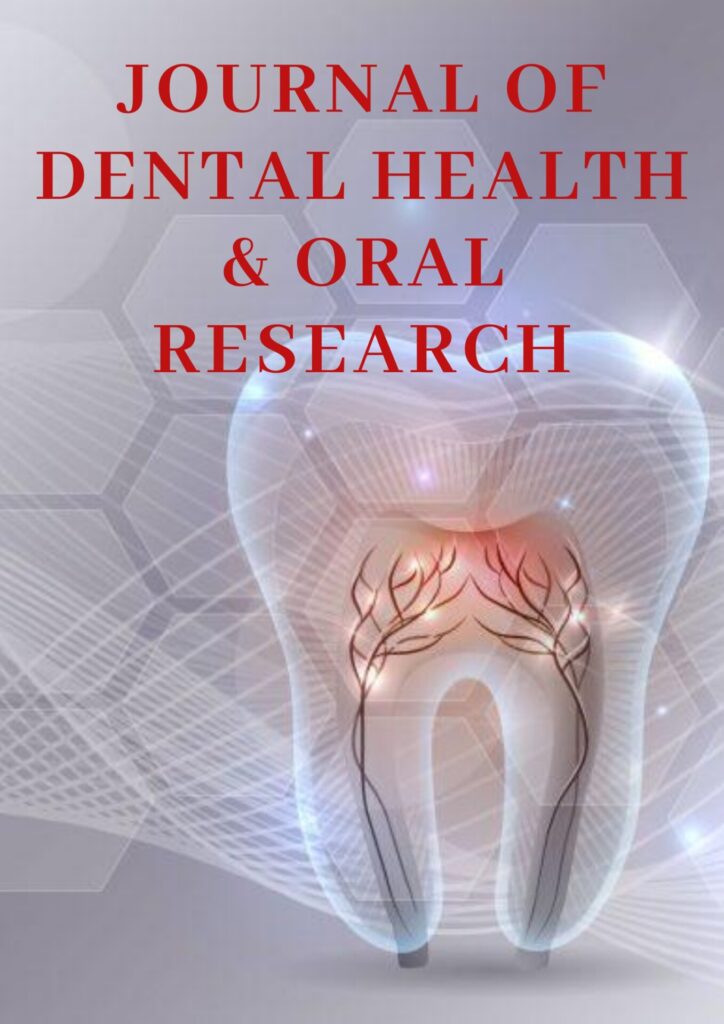Research Article | Vol. 6, Issue 1 | Journal of Dental Health and Oral Research | Open Access |
Failure Rates of Tooth-Supported Crown Restorations in an Academic Dental Center
Shah S1, Kapadia U2, Buch S3, Challa P4, Nalliah RP5*
1Quality Analyst, University of Michigan School of Dentistry. 1011 N. University, Ann Arbor, MI, 48109, USA
2DMD Candidate, Tufts School of Dental Medicine. 1 Kneeland St, Boston, MA, 02111, USA
3Summer Research Intern, University of Michigan School of Dentistry. 1011 N. University, Ann Arbor, MI, 48109, USA
4DDS Candidate for NYU College of Dentistry, 345 E 24th St, New York, NY 10010, USA
5Associate Dean for Patient Services, University of Michigan School of Dentistry. 1011 N. University, Ann Arbor, MI, 48109, USA
*Correspondence author: Romesh Nalliah, Associate Dean for Patient Services, University of Michigan School of Dentistry. 1011 N. University, Ann Arbor, MI, 48109, USA; E-mail: [email protected]
Citation: Shah S, et al. Failure Rates of Tooth-Supported Crown Restorations in an Academic Dental Center. J Dental Health Oral Res. 2025;6(1):1-6.
Copyright© 2025 by Shah S, et al. All rights reserved. This is an open access article distributed under the terms of the Creative Commons Attribution License, which permits unrestricted use, distribution, and reproduction in any medium, provided the original author and source are credited.
| Received 16 March, 2025 | Accepted 07 April, 2025 | Published 15 April, 2025 |
Abstract
Background: Accurate documentation of tooth-supported crown restoration failures is crucial for assessing dental care quality. At the University of Michigan School of Dentistry, failure rates from Electronic Health Record (EHR) reports were notably low, however, experts in the quality improvement committee suspected underreporting. The current study aimed to evaluate failure rate through manual chart review (as opposed to electronic report writing) to confirm the accuracy of the electronic reporting and to try to understand true failure rate.
Methods: A retrospective review analyzed 250 consecutive tooth-supported crown restorations placed in predoctoral clinics from May to December 2019. Data from EHRs, including patient details and procedural codes, were compared against manual chart reviews conducted by two calibrated dentist reviewers. Failure was defined as the need for retreatment within two years post-placement. This study assessed failure rates based on tooth type and contributing factors such as biological, esthetic and mechanical issues. The prevalence of miscoding was also evaluated to align EHR-reported failure rates with actual clinical outcomes.
Results: Manual chart reviews identified a 9.6% failure rate – much higher than the <1% reported from EHR data. Maxillary molars showed the highest failure rate at 52.9%, followed by mandibular molars at 43.6%. Miscoding was prevalent, with non-specific codes accounting for discrepancies. Biologic factors, such as recurrent caries, esthetic issues and mechanical failures were notable contributors. The study also found that, in an academic setting, porcelain/ceramic and CEREC crowns had higher failure rates compared to Porcelain-Fused-to-Metal (PFM) crowns.
Conclusion: The study highlights the need for standardized and accurate coding practices in dental education settings to ensure reliable data on crown restoration failures. The wide gap between EHR-reported and manually reviewed failure rates highlights the impact of miscoding. Enhancing training around coding protocols, faculty calibration and EHR system functionalities is essential for improving clinical documentation, supporting student learning and ensuring high-quality patient care.
Keywords: Electronic Health Record; Dentist Reviewers; Porcelain-Fused-to-Metal (PFM) Crowns; CEREC Crowns
Introduction
Documenting the failure rates of tooth-supported crown restorations accurately is an essential part of assessing the quality of dental care in a clinical setting. At the University of Michigan School of Dentistry, failure rates were reported as 0.46% for the period between 2021 and 2022 and 0.67% between 2022 and 2023, based on EHR reports which tracked American Dental Association code on dental procedures. However, these were believed to be underestimated due to improper coding. Non-specific codes such as D2999 and D9999, were observed in some failures but there was no simple way to track these in order to understand the true failure rate.
Crown failures are a major concern for any clinical entity because of the financial implications. However, the concerns are broader in a dental education setting because it also has implications for dental curriculum and quality of teaching.
Accurate coding and documentation are essential for identifying trends in patient treatment results and ensuring compliance with legal standards. This study aimed to measure failure rates by conducting a manual review of every single crown delivered during a fixed period of the study. A secondary goal was to identify instances of miscoding and assess the true failure rates of tooth-supported crown restorations.
Table 1 represents the ADA codes for each type of dental crown procedure.
S.no | ADA Code | Dental Procedures |
1 | D2740A | Cerec Crown |
2 | D2740 | Ceramic/ Porcelain Crown |
3 | D2750 | Porcelain fused to high noble metal |
4 | D2752 | Porcelain fused to metal |
Table 1: ADA codes for each crown procedure.
Methodology
This retrospective study reviewed the charts of 250 tooth-supported crown restorations delivered at the University of Michigan School of Dentistry predoctoral clinics between May and December 2019. We studied post-delivery outcomes for two years after delivery. Two calibrated dentist reviewers conducted a manual chart review to identify crown failures and retreatments. We defined failure as a restoration requiring replacement or retreatment with similar or alternative materials within two years of placement. Failure rates were analyzed by tooth type, including maxillary and mandibular categories and contributing factors such as biological, esthetic and mechanical issues. The study also evaluated the prevalence of miscoding by comparing EHR-derived failure rates with manually reviewed data. This study was deemed exempt from human studies regulations under protocol HUM00131160.
Results
Our study revealed a failure rate of 9.6% (n=24) within two years of crown placement much higher than the less than 1% failure rate determined through EHR audits. The analysis based on Fig. 1 showed that maxillary molars exhibited the highest failure rates at 52.9%, followed by mandibular molars at 43.6%. Mandibular anterior teeth had the lowest failure rate at 5.1%.
According to Fig. 2, factors contributing to failure were categorized into biological, esthetic, mechanical and miscellaneous reasons. Biologic factors, such as recurrent caries, accounted for 15% of failures, while esthetic issues, such as contour and shape discrepancies, contributed to 11%. Mechanical factors, including framework fractures, represented 23% of failures. The majority of failures, 51%, were classified as miscellaneous, reflecting improperly coded or inadequately documented cases. These findings highlight gaps in documentation and coding practices, which contributed to the underreporting of crown failures in EHR records.
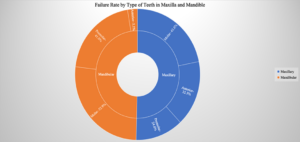
Figure 1: Failure rate by maxillary and mandibular anterior and posterior teeth. 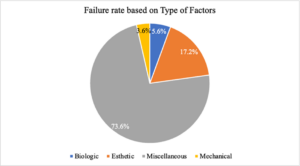
Figure 2: Failure rate based on type of factors.
CROWN | Porcelain/Ceramic Crown | Cerec Crown | Porcelain Fused to Noble Metal Crown | Total |
Number of teeth | 188 | 5 | 57 | 250 |
% of Re-treated/ failure case | 22 (11.7%) | 1 (20%) | 1 (1.7%) | 24 (9.6%) |
Table 2: Failure/ retreated rate of types of crowns.
Discussion
The results of this study show the consequences of improper coding and documentation practices in academic dental settings. The large discrepancy between EHR-reported failure rates and those identified through manual chart reviews highlight the limitations of relying only on electronic records without standardized protocols. The frequent use of non-specific codes, such as D2999 and D9999, led to underreported failure rates and unreliable institutional data. Our manual chart review, as part of the quality assurance evaluation, identified major concerns that were not identified in the electronic reports.
One of our findings was that crowns on molars were failing at a higher rate than crowns on anterior i.e maxillary molars exhibited the highest failure rates at 52.9%, followed by mandibular molars at 43.6%. Mandibular anterior teeth had the lowest failure rate at 5.1%. Anterior and this is aligned with existing knowledge about the increased biomechanical stress and occlusal loads on posterior teeth [2]. Previous studies have shown that, for lithium disilicate glass-ceramic crowns, success rates can be 0.1% [3] to 0.06% [4]. Another study has shown a slightly better success rate in porcelain inlays and onlays compared to full-coverage gold restorations [5]. This was in contrast to our findings where porcelain fixed restorations had the worst outcome with 11.7% failed.
In our study, the most common reason for failure was documented as “miscellaneous” which inhibits learning and improvement. Among other reasons, aesthetics was highest with 17.2%, then biological failure (5.6%) and then mechanical (3.6%). These findings indicate a need for more clarity and consistency in documentation, underscoring the need for improvements in coding practices.
According to the results in Fig. 3,4 after comparing maxillary and mandibular teeth, it was observed that mandibular teeth exhibited a higher failure rate of 13.2%, while maxillary teeth had a failure rate of 6.9%. It also provides an analysis regarding the failure rate of the type of material used to fabricate dental crowns. Porcelain/ ceramic crowns and CEREC crowns have higher failure compared to porcelain fused to metal. A previous study also suggests that long-term success comes from proper tooth preparation, accurate reliable impression- either conventional or digital, cementation techniques, high quality of the final crown and its adaptability, occlusion, contacts and contours [3]. Fig. 3 shows failure rates by tooth type revealing that molars experienced the highest failures- 12, premolars- 7 and anterior teeth had the least – 5.
The findings also emphasize the importance of faculty calibration and training in proper record-keeping [1]. Accurate documentation serves as a legal requirement and a foundation for evaluating clinical outcomes and improving patient care. By addressing these issues, dental schools can better support predoctoral students in understanding factors contributing to treatment success and failure, while enhancing the overall quality of care delivered in academic settings.
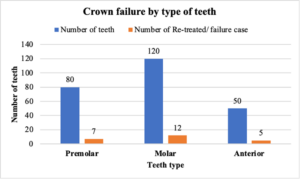
Figure 3: Crown Failure by anterior and posterior teeth.
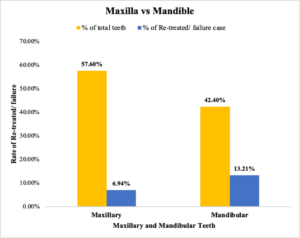
Figure 4: Crown failure rate by maxillary and mandibular teeth.
Conclusion
This study demonstrates the critical need for accurate coding and documentation in reporting tooth-supported crown restoration failures. The failure rate of 9.6% uncovered through manual chart reviews contrasts sharply with the <1% reported in EHR audits, primarily due to miscoding practices. Maxillary and mandibular molars exhibited the highest failure rates, while anterior teeth were the least affected. Improving coding protocols, faculty calibration and EHR systems are essential to enhance data reliability and ensure better patient care. Recommendations include standardizing coding practices, providing comprehensive training for students and faculty, implementing automated failure tracking in EHR systems and conducting periodic audits to align electronic data with manual findings. Future research should focus on developing automated solutions for tracking outcomes and exploring inter-institutional comparisons of methodologies.
Conflict of Interest
The authors declare no conflict of interest. This study was conducted independently as a quality assurance initiative to improve documentation and reporting practices.
Human Ethics and Consent to Participate Declarations
Not Applicable
Consent To Participate
Not Applicable
Funding
This research did not receive any specific grant from funding agencies in the public, commercial or not-for-profit sectors.
Reference
- American Dental Association. Documentation Patient Records. [Last accessed on: April 07, 2025]
https://www.ada.org/en/resources/practice/practice-management/documentation-patient-records
- Hyde JD, Bader JA, Shugars DA. Provisional crown failures in dental school predoctoral clinics. Journal of Dental Education. 2007;71(11):1414-9.
- Margvelashvili-Malament M, Thompson V, Polyakov V, Malament KA. Over 14-year survival of pressed max lithium disilicate glass-ceramic complete and partial coverage restorations in patients with severe wear: A prospective clinical study. J Prosthet Dent. 2024.
- Jiang Q, Wang Z, Zhang S, Liu X, Fu B. Performance of bonded lithium disilicate partial-coverage crowns in the restoration of endodontically treated posterior teeth: An up to seven-year retrospective study. Oper Dent. 2024;49(4):365-75.
- Krug R, Droste L, Schreiber C, Reichardt E, Krastl G, Hahn B, et al. Long-term performance of ceramic in/-onlays vs. cast gold partial crowns: A retrospective clinical study. Clin Oral Investig. 2024;28(5):298.
Author Info
Shah S1, Kapadia U2, Buch S3, Challa P4, Nalliah RP5*
1Quality Analyst, University of Michigan School of Dentistry. 1011 N. University, Ann Arbor, MI, 48109, USA
2DMD Candidate, Tufts School of Dental Medicine. 1 Kneeland St, Boston, MA, 02111, USA
3Summer Research Intern, University of Michigan School of Dentistry. 1011 N. University, Ann Arbor, MI, 48109, USA
4DDS Candidate for NYU College of Dentistry, 345 E 24th St, New York, NY 10010, USA
5Associate Dean for Patient Services, University of Michigan School of Dentistry. 1011 N. University, Ann Arbor, MI, 48109, USA
*Correspondence author: Romesh Nalliah, Associate Dean for Patient Services, University of Michigan School of Dentistry. 1011 N. University, Ann Arbor, MI, 48109, USA; E-mail: [email protected]
Copyright
Shah S1, Kapadia U2, Buch S3, Challa P4, Nalliah RP5*
1Quality Analyst, University of Michigan School of Dentistry. 1011 N. University, Ann Arbor, MI, 48109, USA
2DMD Candidate, Tufts School of Dental Medicine. 1 Kneeland St, Boston, MA, 02111, USA
3Summer Research Intern, University of Michigan School of Dentistry. 1011 N. University, Ann Arbor, MI, 48109, USA
4DDS Candidate for NYU College of Dentistry, 345 E 24th St, New York, NY 10010, USA
5Associate Dean for Patient Services, University of Michigan School of Dentistry. 1011 N. University, Ann Arbor, MI, 48109, USA
*Correspondence author: Romesh Nalliah, Associate Dean for Patient Services, University of Michigan School of Dentistry. 1011 N. University, Ann Arbor, MI, 48109, USA; E-mail: [email protected]
Copyright© 2025 by Shah S, et al. All rights reserved. This is an open access article distributed under the terms of the Creative Commons Attribution License, which permits unrestricted use, distribution, and reproduction in any medium, provided the original author and source are credited.
Citation
Citation: Shah S, et al. Failure Rates of Tooth-Supported Crown Restorations in an Academic Dental Center. J Dental Health Oral Res. 2025;6(1):1-6.

